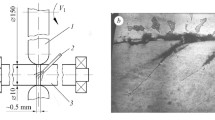Abstract
The author verified the hypothesis that the linear additivity of the fatigue damage of specimens tested under programmed loading conditions is unaffected by variations in the parameters of a seven-step program module; stress and number of cycles at each stress level. The tests were carried out in rotating bending at a frequency of 3000 rpm, water being used as the corrosive medium. It was shown that, irrespective of the intensity of damage at each module step, the sums of the relative endurances a are close to one: The values obtained for nine different programs ranged from 1.05 to 1.57. The endurance values obtained for specimens tested in water under programmed loading conditions obey the logarithmically normal distribution law.
Similar content being viewed by others
References
A. V. Karlashov and A. D. Gnatyuk, FKhMM [Soviet Materials Science], no. 3, 1966.
A. V. Karlashov and A. D. Gnatyuk, FKhMM [Soviet Materials Science], no. 1, 1967.
M.E. Garf, ZL, no. 1, 1962.
A. K. Mitropol'skii, Statistical Calculations Techniques [in Russian], Fizmatgiz, Moscow, 1961.
A. Khald, Mathematical Statistics with Technological Applications, [Russian translation], IL, Moscow, 1956.
Author information
Authors and Affiliations
Rights and permissions
About this article
Cite this article
Nazarenko, G.T. Accumulation of fatigue damage during programmed loading of steel 30KhN3A in corrosive media. Mater Sci 4, 241–243 (1968). https://doi.org/10.1007/BF00938097
Issue Date:
DOI: https://doi.org/10.1007/BF00938097




